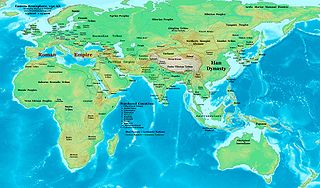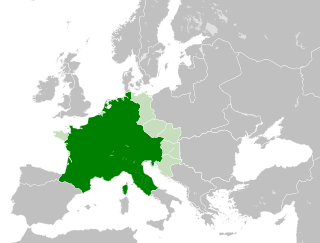This page is based on this
Wikipedia article Text is available under the
CC BY-SA 4.0 license; additional terms may apply.
Images, videos and audio are available under their respective licenses.
The 540s decade ran from January 1, 540, to December 31, 549.
The 550s decade ran from January 1, 550, to December 31, 559.
The 560s decade ran from January 1, 560, to December 31, 569.

The Silk Road was an ancient network of trade routes that connected the East and West. It was central to cultural interaction between the regions for many centuries. The Silk Road primarily refers to the terrestrial routes connecting East Asia and Southeast Asia with East Africa, West Asia and Southern Europe.

A dynasty is a sequence of rulers from the same family, usually in the context of a feudal or monarchical system, but sometimes also appearing in elective republics. Alternative terms for "dynasty" may include "house", "family" and "clan", among others. The longest-surviving dynasty in the world is the Imperial House of Japan, otherwise known as the Yamato dynasty, whose reign is traditionally dated to 660 BC.

The history of the world, in common parlance, is the history of humanity, as determined from archaeology, anthropology, genetics, linguistics, and other disciplines; and, for periods since the invention of writing, from recorded history and from secondary sources and studies.

Sino-Roman relations comprised the mostly indirect contact, flow of trade goods, information, and occasional travellers between the Roman Empire and Han Empire of China, as well as between the later Eastern Roman Empire and various Chinese dynasties. These empires inched progressively closer in the course of the Roman expansion into the ancient Near East and simultaneous Han Chinese military incursions into Central Asia. Mutual awareness remained low, and firm knowledge about each other was limited. Only a few attempts at direct contact are known from records. Intermediate empires such as the Parthians and Kushans, seeking to maintain lucrative control over the silk trade, inhibited direct contact between these two Eurasian powers. In 97 AD, the Chinese general Ban Chao tried to send his envoy Gan Ying to Rome, but Gan was dissuaded by Parthians from venturing beyond the Persian Gulf. Several alleged Roman emissaries to China were recorded by ancient Chinese historians. The first one on record, supposedly from either the Roman emperor Antoninus Pius or his adopted son Marcus Aurelius, arrived in 166 AD. Others are recorded as arriving in 226 and 284 AD, with a long absence until the first recorded Byzantine embassy in 643 AD.
This is a timeline showing the dates when countries or polities made Christianity the official state religion, generally accompanying the baptism of the governing monarch.















